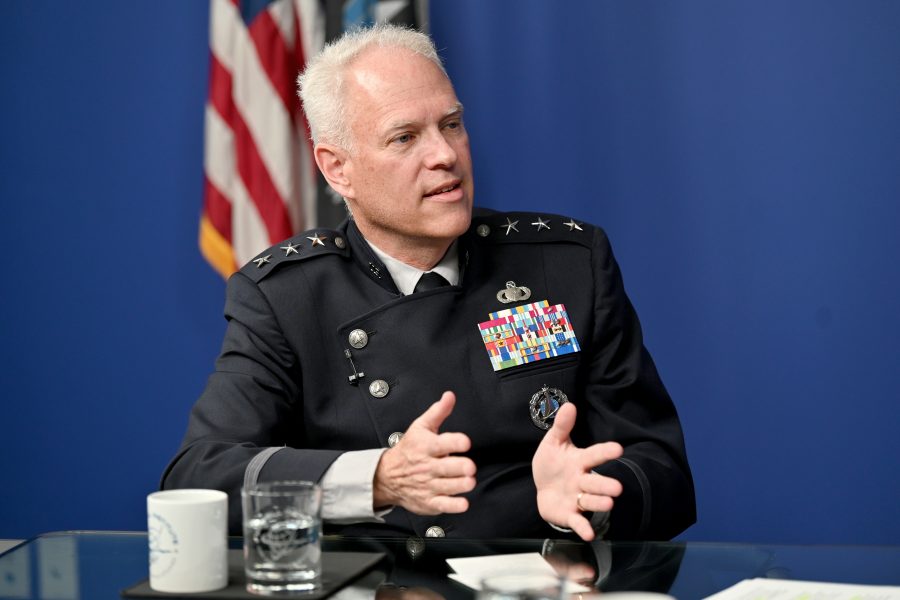The Space Force will stand up its new Space Futures Command and two new Integrated Mission Deltas this summer, said Lt. Gen. Philip A. Garrant, head of Space Systems Command.
Garrant shared the new details during a Mitchell Institute for Aerospace Studies event on May 21.
Integrated Mission Deltas will combine operations and sustainment under one roof, with the goal of more delivering upgrades more rapidly than is possible today. Chief of Space Operations B. Chance Saltzman announced the first two Integrated Mission Deltas as a pilot program in September 2023, with one focused on electronic warfare (EW) and the other on position, navigation, and timing (PNT). By February 2024, the new units were already getting rave reviews.
“The ability to combine those units under a single umbrella, to be able to focus on unified mission readiness, has paid some tremendous benefits to this point,” said Col. Andrew Menschner, commander of the Position, Navigation, and Timing Delta (Provisional) in February at the AFA Warfare Symposium.
Now Garrant said it’s time for the next step. “We are expanding the concept this summer,” he said. “We’re doing the mission analysis to expand on the missile warning mission area as well as space domain awareness.”
Garrant and his counterpart at Space Operations Command, Lt. Gen. David N. Miller, are leading the analysis work together. The two will present Saltzman with a progress report in the next few weeks, Garrant said.
Most affected by the upcoming changes are Space Delta 2, which handles space domain awareness, and Space Delta 4, which covers missile warning. But USSF is looking to move aggressively on other mission areas, too.
“The long-term intent is, over the course of the next year and a half, to finish out the rest of the mission areas,” Garrant said. He singled out satellite communications and orbital warfare as possibly the next two.
But Garrant also cautioned that expanding the concept still requires careful planning.
“It is a pretty significant lift when they look at organizational change requests and some of the restructuring, and then making sure that we’re not hurting anyone’s career,” Garrant said. “When we stand up these [Deltas], we’re not making anyone lose their jobs. So it’s a very deliberate process.”
Space Futures Command
Moving up the command hierarchy, Garrant also signaled progress on the Space Force’s fourth Field Command, to be called Space Futures Command. First announced in February as part of the Department of the Air Force’s “re-optimization” for great power competition, Space Futures will focus on long-term questions about force structure, technologies, and capability development.
“The intent is to [make Space Futures Command] active, provisionally, by August,” Garrant said. “It will be another very geographically diverse command.”
Lt. Gen. Shawn Bratton, the Space Force’s chief planning officer, said in February that a task force to lay the groundwork for standing up the command could be in place by “the beginning of summer,” and that the command could achieve initial operational capability by the end of 2024.
Space Futures Command will consist of a headquarters element and three centers:
- Headquarters: Garrant said the headquarters will be commanded by a general officer, and draw manpower from the Futures and Integration element of the Space Staff, a group currently led by Col. Carl Bottolfson.
- The Space Warfighting Analysis Center: The center is currently a direct reporting unit to the Space Staff and is based in Washington, D.C.
- The Space Wargaming Center: This new center will be led by Space Delta 10, which is responsible for doctrine and wargaming in Space Training and Readiness Command. It is currently led by Col. Jack D. Fulmer II.
- The Concepts and Technologies Center: This center will also be entirely new. Garrant said it will be led by Col. Peter Mastro, the senior materiel leader for the Tactical Command, Control, and Communication Delta in SSC.
“The idea is they will build that future force that then goes into the programmed force which ultimately we hope becomes a fielded force,” Garrant said. “Gen. Saltzman likes to talk about risk of mission being the difference between those three forces: the force design that we want, the force design that’s budgeted, and the force design that we have.”
Each of the three existing field commands—SSC, Space Operations Command, and Space Training and Readiness Command—will contribute to the formation of Space Futures Command, Garrant added
“Whether it’s the wargaming or it’s the mission area teams from SpOC or in our case, the S&T and some of the initial engineering and architecture work that our integration office does, they will all be working with or for Space Futures Command,” said Garrant. Those decisions haven’t been made yet, but we might actually move people from SSC into Futures. They’ll still stay in Los Angeles so they’re connected to our organization.”
